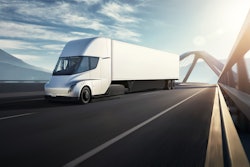If the federal Highway Trust Fund is to remain solvent over the next decade and beyond with the expected growth of electric vehicles, Congress will need to implement a tax on EVs for their use of highways, according to a study released in late September by the American Transportation Research Institute.
Even with a small percentage of battery-electric vehicles on the road today (just over 1 million sold in the U.S. out of 276 million registered vehicles), the Highway Trust Fund has struggled to stay solvent. The current 18.3-cent gasoline tax and 24.3-cent diesel tax hasn’t been raised since 1993, “even while fuel consumption has increased substantially over the past 30 years,” ATRI said. Additionally, cars and trucks today can travel farther on a gallon of fuel than they could in the early 1990s, further decreasing the amount of money coming into the HTF from fuel taxes.
According to the report, EV sales are projected to grow to 19 million EVs on the road by 2030, with approximately 15.2 million of those being battery-electric vehicles, which consume no gasoline. And as it currently stands, EV owners pay no federal tax to generate funds for the HTF.
ATRI’s study looked at three potential ways to tax EV owners, both passenger and commercial vehicles, to generate funding for the HTF: State-level registration fees, a vehicle miles traveled tax, and a so-called electric fuel tax, which would be based on an electric vehicle’s electricity usage, similar to the current gasoline and diesel taxes.
While registration fees could help, there is no direct link between those fees and vehicle use. Dan Murray, Senior Vice President of ATRI, said some states have looked at taking the national average of miles traveled, which is around 11,599 miles per year, and charging a registration fee based on those miles and what that equates to in a fuel tax. The problem with that is that some fleet cars may travel upwards of 20,000 miles a year, while some cars driven by the elderly population may only travel a few hundred miles a year, which would lead to unfair taxing on both sides.
“At the end of the day, the registration fee is sort of throwing a dart at a dart board,” Murray said. “It’s a series of guesses, and then rounding the numbers up or down. That’s not the most efficient, nor the most technical and scientific way of charging somebody for the roads they use, the damage they do.”
 Hear more about how EVs can be taxed to generate revenue for the Highway Trust Fund on this week's 10-44 webisode in the video above.
Hear more about how EVs can be taxed to generate revenue for the Highway Trust Fund on this week's 10-44 webisode in the video above.
With the VMT model, ATRI addressed this in a previous study that found that the cost of implementing a VMT nationwide would be more expensive than the revenue gains.
Finally, the electric fuel tax model would work the same way as the current fuel tax, as users would be charged based on how much energy their vehicles consume – whether they’re charging at home, their business or at a public charging station.
ATRI determined that gas-powered cars consume on average 3.2 gallons of gasoline per 100 miles and battery-electric vehicles consume an average of 28 kilowatt-hours (kWh) of electricity per 100 miles to find that an electricity tax of 2.1 cents per kWh would be equivalent to the current gasoline tax.
Murray said there are a several ways public utilities can determine electricity used for vehicle charging compared to other uses, the easiest being measuring electricity used at public and private charging stations with a meter on them, since the only thing hooking up to those chargers are vehicles. A tax could easily be added to the cost of using the chargers.
Another option, mostly for home charging of passenger vehicles, is the use of smart meters and smart chargers. Smart chargers talk to smart meters, which are becoming more common, Murray said, and can determine the difference in various sources of energy use, such as for charging a vehicle, operating the air conditioner, etc.
One problem the U.S. is likely to run into, however, as more people make the switch from internal combustion to battery-electric vehicles, Murray added, is that the “country doesn’t generate enough electricity to convert the gasoline fleet to the public utility fleet,” he said. “We’re not generating as a country enough electricity.”
Murray used an example of an unnamed large fleet that was planning to build a terminal in a large Illinois city (not Chicago) and have 20 to 25 charging stations for Class 8 trucks – a much larger demand for electricity than for cars. After submitting the blueprints to the city, the city was alarmed at the “massive electrical grid system” it was building and asked what it was.
After responding that it was for electric trucks the fleet planned to add to its fleet in the coming years, the city said that “electrical draw is greater than the entire draw of the city of ‘X’ in Illinois,” he said. “They don’t have the capacity or the grid to accommodate a single truck terminal with 20, 25 stalls. While this report we just released teaches you sort of at a very prescriptive level how to do it and what to charge, this country’s got to roll up its sleeves and figure out where in the world all this electricity’s going to come from as we move relatively quickly into a relatively large electric vehicle fleet.”












